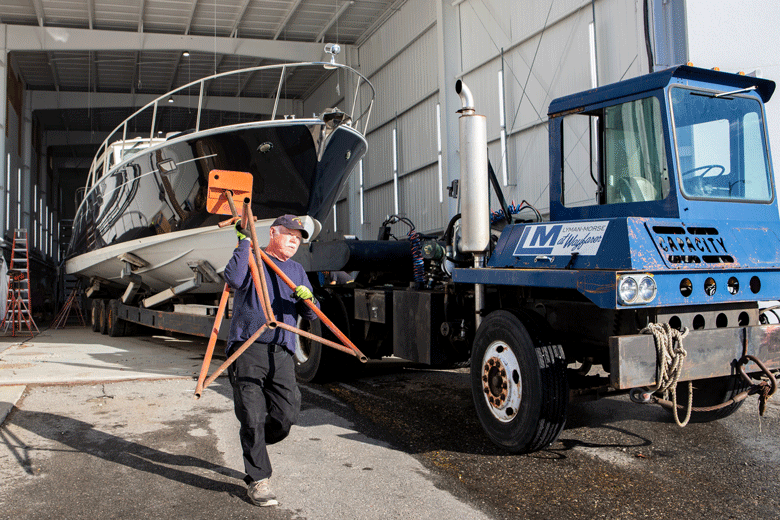Think of Maine and some classic images come to mind. The North Woods. Blueberry barrens. A rockbound coastline dotted with tiny communities where fishermen land their harvest of Maine’s iconic lobster. The image likely includes lobster boats moored in a placid harbor, often among handsome sailboats or sleek powerboats.
Most of those boats, both the rugged fishing boats that bring millions of dollars of lobsters and other sea creatures ashore each year and the elegant yachts, were likely built by Maine boatbuilders, continuing a tradition that dates back a century or more.
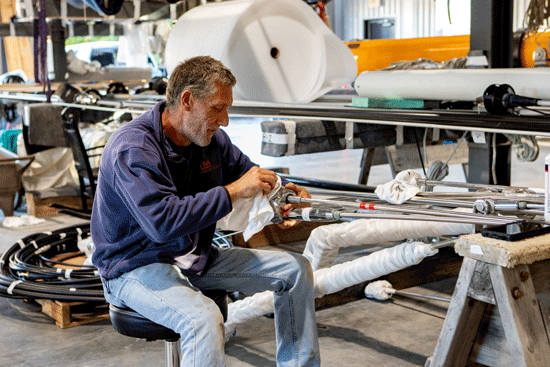
Historians name the 51-foot sailing vessel Virginia, launched by English settlers at the mouth of the Kennebec River in 1607, as the first ship built by Europeans in the New World, but even if one doesn’t look that far back Maine had a well-established boatbuilding industry by the early 19th century. Shipyards along the coast built square-riggers and schooners that engaged in worldwide commerce—Bath Iron Works was founded in 1884—and countless boatyards built small fishing vessels, some, like the Friendship sloop and the peapod, still synonymous with Maine though primarily used for recreation by 21st Century “rusticators.”
According to the industry trade association Maine Built Boats, boatbuilding in the state generates annual industrywide sales of more than $650 million and some 5,000 jobs. Many of those jobs are at the shipbuilder Bath Iron Works or larger yacht builders famous for their craftsmanship and technology, but there are also plenty of small boat shops where a few artisans—sometimes a single craftsman—hand build boats as elegant and technologically advanced as any.
Some builders craft boats that trace their lineage directly to the boats used a century or more ago for fishing in Casco Bay, around Vinalhaven, or Beals Island, with the modern lobster boat’s lines developed by designers such as Calvin Beal Jr., Ernest Libby, and the Lowell brothers—Royal and Carroll—among others. Some shops build sail or powerboats from the lines of such iconic yacht designers as Nathaniel Herreshoff or Maine’s own Joel White, or work with naval architects from around the world who draw boats at the leading edge of design.
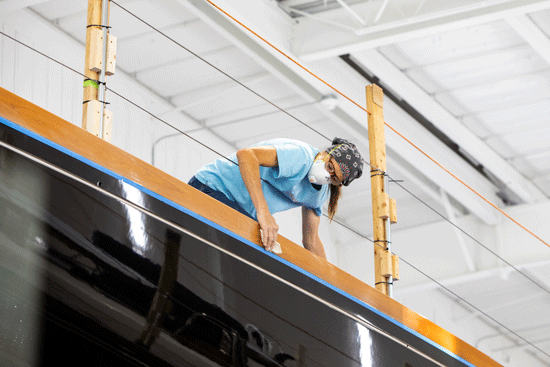
Some boat shops are run by artisans who learned boatbuilding from their fathers or grandfathers. In Bass Harbor, Richard Stanley builds wooden lobster boats and sailboats using techniques he learned from his father, Ralph Stanley, famous for his Friendship sloops.
In Yarmouth, the Lowell brothers are sixth-generation boatbuilders, descended from the legendary Will Frost, the “father” of the modern Maine lobster boat, who began building Maine’s first engine-powered fishing boats on Beals Island more than a century ago. And there are a great many small boat shops along the coast without the historical connections but still building classic wooden boats—sailing and power, working or recreational.
Some of Maine’s best-known yacht builders also have deep connections to Maine’s boatbuilding history.
Hodgdon Yachts, founded in 1816, is still family run and builds elegant custom sailing and power yachts, and high-speed tenders for megayachts, in East Boothbay. A few years ago, Hodgdon built an enormous oven at its boat yard to bake the carbon-fiber hull and components for a record setting 100-foot sailing yacht.
Hinckley, synonymous with fine American yachts, builds its picnic boats, powerboats, and sailboats a few miles up the road from the Southwest Harbor boatyard where Henry R. Hinckley started the company in 1928 and built his first boat in 1933.
Lyman-Morse, a relative “newcomer” founded in 1978, builds custom yachts in Thomaston, continuing a tradition of boatbuilding in the former Morse family boatyard dating back more than a century.
Sabre Yachts, founded in 1970, and the younger, related Back Cove Yachts, may lack history but not pedigree. Virtually unique in Maine, Sabre and Back Cove sell their motor yachts through dealers, not directly to individual customers. The boats themselves allow relatively limited customization, but all feature a Downeast look and modern production techniques coupled with traditional Maine craftsmanship.
Large or small, Maine’s boatbuilders are a happy bunch, Phil Bennett, Hinckley’s longtime vice-president for sales and marketing and now a senior business advisor to the company, said recently.
“Stop in and ask for a cup of coffee in pretty much any boat shop and you’ll see smiling faces,” he said.
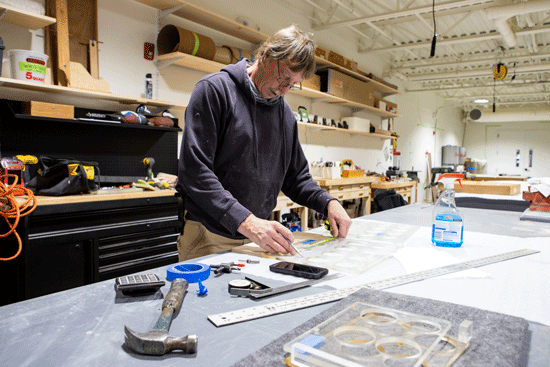
yacht. PHOTO: JACK SULLIVAN
Because companies best known for their custom yachts—Hinkley, Lyman-Morse, Brooklin Boat Yard, Hodgdon, and a few others—“are not high-volume builders,” Bennett said, none of them has “a huge orderbook they have to build” to stay profitable. The companies he mentioned, and most smaller Maine boatbuilders too, build their boats, whether fiberglass lobster boats or custom wooden sailing yachts, to order rather than on spec. “Their order books are full,” Bennett said.
Wesmac Custom Boats builds large and expensive, fiberglass lobster boats, research and patrol boats for state environmental and enforcement agencies, and “battlewagon” sportfishermen that venture far offshore hunting trophy-winning gamefish. President Steve Wessel echoed Bennett’s take.
“Business is extremely strong, and it’s been strong for quite a while,” Wessel said recently. “We could build as many boats as we want.”
But Wesmac can’t really do that. Citing the wait time for a new boat of up to five years for potential customers, Wessel said “We’re turning a lot of work away.” The principal reason for the lengthy delay? “We can’t get enough help.”
Wesmac is hardly the only Maine boatbuilder coping with a labor shortage. Hinckley, advertising jobs on Facebook recently, was offering a $2,000 sign-on bonus for experienced marine carpenters and was trying to fill several other production jobs.
Even Bath Iron Works is in a constant hunt for workers, currently advertising jobs ranging “from accounting to engineering to pipefitting to design and everything in between.”
“There’s not one boatbuilder that wouldn’t hire X number of people, if they could get them,” Bennett said.
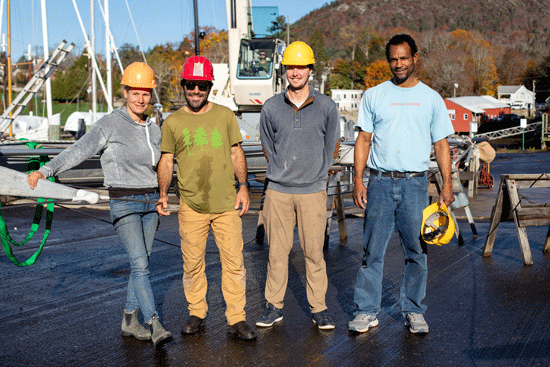
and Junior of Lyman Morse after the group successfully unstepped the mast
of the schooner as part of the storage-preparation process
Bennett attributed at least some of the labor shortage to the recent construction boom that sucked workers away from boatbuilding. And while he noted a recent shift by some young Mainers away from four-year colleges into technical education and traditional trades, he and Wessel both said there was some apparent reluctance among new workers to put in the long hours busy boatbuilders demand.
Assuming boatbuilders can find the help they need as construction slows, they still face plenty of issues. Wessel cited rapid and unpredictable increases in the cost of essential materials like fiberglass and resin. Bennett and other boatbuilders talked about supply chain problems that have rendered some parts and basic materials virtually unobtainable by manufacturers and suppliers Maine boatbuilders depend on.
Also on the horizon, particularly for boat shops building lobster boats, is the uncertain impact of coming federal whale protection regulations on the lobster industry. That uncertainty is compounded by the extremely low boat price for lobster this summer coupled with the high costs—primarily for diesel fuel and bait—of fishing.
While the labor market always fluctuates and supply chain problem will abate eventually, Bennett said, boatbuilders, like fishermen, face diminishing access to the waterfront. As more people, many of them with substantial assets, move to Maine, boatyards and other shorefront owners are facing increased pressure to sell their property. Another concern: the cost of compliance with stricter environmental and workplace safety regulations, most acute for smaller boat shops.
Still, the outlook for Maine boatbuilders is hardly bleak. The industry has survived wars, depressions, a punitive luxury tax and is still going strong. The best evidence: several boatyards launched substantial new projects—commercial and recreational—in recent months and have more big projects under construction or on order.
“I’m very optimistic,” Bennett said, “because we are different and people are starting to recognize that.”
